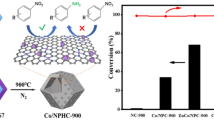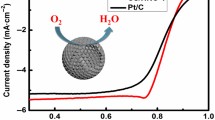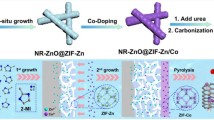Abstract
Designing reasonable MOFs-derived carbon materials to further effectively improve the catalytic activity toward ORR in the practical application of fuel cells is very necessary but remains a great challenge. Herein, a new facile yet robust strategy, self-sacrifice template approach combined with a variety of MOFs, to achieve core–shell ZnO@zeolitic imidazolate frameworks precursor (ZnO@ZIF-8@ZIF-67) is developed. Subsequently, the porous hybrid hollow carbon shell (Zn/Co-NC) can be obtained by calcinating the precursor. Impressively, the Zn/Co-NC-800 prepared by pyrolysis at 800 °C manifests excellent ORR performances with a positive onset potential of 1.03 V (vs. reversible hydrogen electrode) (vs. RHE), a more positive half-wave potential at 0.856 V (vs. RHE, a positive shift of 28 mV compared with the Pt/C) and 4-electron pathway (n = 3.80). Also, it performs higher long-term stability (only a 7.9% decay of initial current density after 20000 s) and better methanol tolerance in comparison with the traditional Pt/C in alkaline media. In our current work, the synthesis strategy of the self-sacrificing template combined with ZIFs opens up a new route for the preparation of highly efficient non-precious metal electrocatalysts for ORR.
Graphical abstract






Similar content being viewed by others
References
Wei PJ, Yu GQ, Naruta Y, Liu JG (2014) Covalent grafting of carbon nanotubes with a biomimetic heme model compound to enhance oxygen reduction reactions. Angew Chem Int Edit 53:6659–6663. https://doi.org/10.1002/anie.201403133
Wu G, More KL, Johnston CM, Zelenay P (2011) High-performance electrocatalysts for oxygen reduction derived from Polyaniline, Iron, and Cobalt. Science 332:443–447. https://doi.org/10.1126/science.1200832
Zhang Y, Zhuang XD, Su YZ, Zhang F, Feng XL (2014) Polyaniline nanosheet derived B/N co-doped carbon nanosheets as efficient metal-free catalysts for oxygen reduction reaction. J Mater Chem A 2:7742–7746. https://doi.org/10.1039/c4ta00814f
Zhang JT, Zhao ZH, Xia ZH, Dai LM (2015) A metal-free bifunctional electrocatalyst for oxygen reduction and oxygen evolution reactions. Nat Nanotechnol 10:444–452. https://doi.org/10.1038/Nnano.2015.48
Jiang WJ, Gu L, Li L et al (2016) Understanding the high activity of Fe-N-C electrocatalysts in oxygen reduction: Fe/Fe3C nanoparticles boost the activity of Fe-N(x). J Am Chem Soc 138:3570–3578. https://doi.org/10.1021/jacs.6b00757
Li Q, Cao R, Cho J, Wu G (2014) Nanocarbon electrocatalysts for oxygen reduction in alkaline media for advanced energy conversion and storage. Adv Energy Mater 4:1301415. https://doi.org/10.1002/aenm.201301415
Liang YY, Wang HL, Diao P et al (2012) Oxygen reduction electrocatalyst based on strongly coupled cobalt oxide nanocrystals and carbon nanotubes. J Am Chem Soc 134:15849–15857. https://doi.org/10.1021/ja305623m
Chang HY, Lee KY (2015) Characteristics of nitrogen-doped carbon films grown by sputtering as potential cathode catalysts for oxygen reduction reaction. Jpn J Appl Phys. https://doi.org/10.7567/JJAP.54.085801
Choe JE, You JM, Yun M et al (2015) Manganese Dioxide/reduced graphene oxide with Poly(3,4-ethylenedioxythiophene) for improved electrocatalytic oxygen reduction reaction. J Nanosci Nanotechno 15:5684–5690. https://doi.org/10.1166/jnn.2015.10284
Cui LL, Lv GJ, He XQ (2015) Enhanced oxygen reduction performance by novel pyridine substituent groups of iron (II) phthalocyanine with graphene composite. J Power Sources 282:9–18. https://doi.org/10.1016/j.jpowsour.2015.02.031
Shao YY, Yin GP, Gao YZ (2007) Understanding and approaches for the durability issues of Pt-based catalysts for PEM fuel cell. J Power Sources 171:558–566. https://doi.org/10.1016/j.jpowsour.2007.07.004
Li QH, Chen WX, Xiao H et al (2018) Fe isolated single atoms on S, N codoped carbon by copolymer pyrolysis strategy for highly efficient oxygen reduction reaction. Adv Mater 30:1800588. https://doi.org/10.1002/adma.201800588
Ye YF, Cai F, Li HB et al (2017) Surface functionalization of ZIF-8 with ammonium ferric citrate toward high exposure of Fe-N active sites for efficient oxygen and carbon dioxide electroreduction. Nano Energy 38:281–289. https://doi.org/10.1016/j.nanoen.2017.05.042
Gong KP, Du F, Xia ZH, Durstock M, Dai LM (2009) Nitrogen-doped carbon nanotube arrays with high electrocatalytic activity for oxygen reduction. Science 323:760–764. https://doi.org/10.1126/science.1168049
Shinde SS, Lee CH, Sami A, Kim DH, Lee SU, Lee JH (2017) Scalable 3-D carbon nitride sponge as an efficient metal-free bifunctional oxygen electrocatalyst for rechargeable Zn-Air batteries. ACS Nano 11:347–357. https://doi.org/10.1021/acsnano.6b05914
Wei DC, Liu YQ, Zhang HL et al (2009) Scalable synthesis of few-layer graphene ribbons with controlled morphologies by a template method and their applications in nanoelectromechanical switches. J Am Chem Soc 131:11147–11154. https://doi.org/10.1021/ja903092k
Torad NL, Salunkhe RR, Li YQ et al (2014) Electric double-layer capacitors based on highly graphitized nanoporous carbons derived from ZIF-67. Chem-Eur J 20:7895–7895. https://doi.org/10.1002/chem.201400089
Liu YY, Jiang HL, Zhu YH, Yang XL, Li CZ (2016) Transition metals (Fe Co, and Ni) encapsulated in nitrogen-doped carbon nanotubes as bi-functional catalysts for oxygen electrode reactions. J Mater Chem A 4:1694–1701. https://doi.org/10.1039/c5ta10551j
Huang YB, Liang J, Wang XS, Cao R (2017) Multifunctional metal-organic framework catalysts: synergistic catalysis and tandem reactions. Chem Soc Rev 46:126–157. https://doi.org/10.1039/c6cs00250a
Liu JW, Chen LF, Cui H, Zhang JY, Zhang L, Su CY (2014) Applications of metal-organic frameworks in heterogeneous supramolecular catalysis. Chem Soc Rev 43:6011–6061. https://doi.org/10.1039/c4cs00094c
Ahn SH, Klein MJ, Manthiram A (2017) 1D Co- and N-Doped hierarchically porous carbon nanotubes derived from bimetallic metal organic framework for efficient oxygen and tri-iodide reduction reactions. Adv Energy Mater 7:1601979. https://doi.org/10.1002/aenm.201601979
Zhang GJ, Li CX, Liu J et al (2014) One-step conversion from metal-organic frameworks to Co3O4@N-doped carbon nanocomposites towards highly efficient oxygen reduction catalysts. J Mater Chem A 2:8184–8189. https://doi.org/10.1039/c4ta00677a
Hupp JT, Poeppelmeier KR (2005) Better living through nanopore chemistry. Science 309:2008–2009. https://doi.org/10.1126/science.1117808
Qiu SL, Zhu GS (2009) Molecular engineering for synthesizing novel structures of metal-organic frameworks with multifunctional properties. Coordin Chem Rev 253:2891–2911. https://doi.org/10.1016/j.ccr.2009.07.020
Park KS, Ni Z, Cote AP et al (2006) Exceptional chemical and thermal stability of zeolitic imidazolate frameworks. P Natl Acad Sci USA 103:10186–10191. https://doi.org/10.1073/pnas.0602439103
Huang XC, Lin YY, Zhang JP, Chen XM (2006) Ligand-directed strategy for zeolite-type metal-organic frameworks: Zinc(II) imidazolates with unusual zeolitic topologies. Angew Chem Int Edit 45:1557–1559. https://doi.org/10.1002/anie.200503778
Kuo CH, Tang Y, Chou LY et al (2012) Yolk-Shell Nanocrystal@ZIF-8 Nanostructures for Gas-Phase Heterogeneous Catalysis with Selectivity Control. J Am Chem Soc 134:14345–14348. https://doi.org/10.1021/ja306869j
Xia BY, Yan Y, Li N, Wu HB, Lou XW, Wang X (2016) A metal-organic framework-derived bifunctional oxygen electrocatalyst. Nat Energy 1:15006. https://doi.org/10.1038/Nenergy.2015.6
Xia W, Qu C, Liang ZB et al (2017) High-performance energy storage and conversion materials derived from a single metal organic framework/Graphene Aerogel composite. Nano Lett 17:2788–2795. https://doi.org/10.1021/acs.nanolett.6b05004
Lai QX, Zhu JJ, Zhao YX, Liang YY, He JP, Chen JH (2017) MOF-based metal-doping-induced synthesis of hierarchical porous Cu-N/C oxygen reduction electrocatalysts for Zn-Air batteries. Small 13:1700740. https://doi.org/10.1002/smll.201700740
Zhao Y, Li XF, Yan B et al (2016) Recent developments and understanding of novel mixed transition-metal oxides as anodes in lithium ion batteries. Adv Energy Mater 6:1502175. https://doi.org/10.1002/aenm.201502175
Tang J, Salunkhe RR, Liu J et al (2015) Thermal conversion of core-shell metal-organic frameworks: a new method for selectively functionalized nanoporous hybrid carbon. J Am Chem Soc 137:1572–1580. https://doi.org/10.1021/ja511539a
Liu SH, Wang ZY, Zhou S et al (2017) Metal-organic-framework-derived hybrid carbon nanocages as a bifunctional electrocatalyst for oxygen reduction and evolution. Adv Mater 29:1700874. https://doi.org/10.1002/adma.201700874
Ahn SH, Yu X, Manthiram A (2017) “Wiring” Fe-Nx-embedded porous carbon framework onto 1D nanotubes for efficient oxygen reduction reaction in alkaline and acidic media. Adv Mater 29:1606534. https://doi.org/10.1002/adma.201606534
Li B, Ge XM, Goh FWT et al (2015) Co3O4 nanoparticles decorated carbon nanofiber mat as binder-free air-cathode for high performance rechargeable zinc-air batteries. Nanoscale 7:1830–1838. https://doi.org/10.1039/c4nr05988c
Chen YM, Yu L, Lou XW (2016) Hierarchical tubular structures composed of Co3O4 hollow nanoparticles and carbon nanotubes for lithium storage. Angew Chem Int Edit 55:5990–5993. https://doi.org/10.1002/anie.201600133
Qin JS, Du DY, Guan W et al (2015) Ultrastable polymolybdate-based metal organic frameworks as highly active electrocatalysts for hydrogen generation from water. J Am Chem Soc 137:7169–7177. https://doi.org/10.1021/jacs.5b02688
Ma X, Zhao X, Huang JS, Sun LT, Li Q, Yang XR (2017) Fine Co nanoparticles encapsulated in a N-Doped porous carbon matrix with superficial N-Doped porous carbon nanofibers for efficient oxygen reduction. Acs Appl Mater Inter 9:21747–21755. https://doi.org/10.1021/acsami.7b02490
Zhao YX, Lai QX, Zhu JJ et al (2018) Controllable construction of core-shell polymer@zeolitic imidazolate frameworks fiber derived heteroatom-doped carbon nanofiber network for efficient oxygen electrocatalysis. Small 14:1704207. https://doi.org/10.1002/smll.201704207
Zhang W, Yao X, Zhou S et al (2018) ZIF-8/ZIF-67-Derived Co-Nx-embedded 1D porous carbon nanofibers with graphitic carbon-encased Co nanoparticles as an efficient bifunctional electrocatalyst. Small 14:1800423. https://doi.org/10.1002/smll.201800423
Yin PQ, Yao T, Wu Y et al (2016) Single cobalt atoms with precise N-coordination as superior oxygen reduction reaction catalysts. Angew Chem Int Edit 55:10800–10805. https://doi.org/10.1002/anie.201604802
Banerjee R, Phan A, Wang B et al (2008) High-throughput synthesis of zeolitic imidazolate frameworks and application to CO2 capture. Science 319:939–943. https://doi.org/10.1126/science.1152516
Mahmood A, Guo WH, Tabassum H, Zou RQ (2016) Metal-organic framework-based nanomaterials for electrocatalysis. Adv Energy Mater. https://doi.org/10.1002/aenm.201600423
You SJ, Gong XB, Wang W et al (2016) Enhanced cathodic oxygen reduction and power production of microbial fuel cell based on noble-metal-free electrocatalyst derived from metal-organic frameworks. Adv Energy Mater 6:1501497. https://doi.org/10.1002/aenm.201501497
Yu GL, Sun J, Muhammad F, Wang PY, Zhu GS (2014) Cobalt-based metal organic framework as precursor to achieve superior catalytic activity for aerobic epoxidation of styrene. Rsc Adv 4:38804–38811. https://doi.org/10.1039/c4ra03746d
Li Q, Xu P, Gao W et al (2014) Graphene/graphene-tube nanocomposites templated from cage-containing metal-organic frameworks for oxygen reduction in Li-O-2 batteries. Adv Mater 26:1378–1386. https://doi.org/10.1002/adma.201304218
Zhu YW, Murali S, Cai WW et al (2010) Graphene and graphene oxide: synthesis, properties, and applications. Adv Mater 22:5226–5226. https://doi.org/10.1002/adma.201090156
Lin L, Zhu Q, Xu AW (2014) Noble-metal-free Fe-N/C catalyst for highly efficient oxygen reduction reaction under both alkaline and acidic conditions. J Am Chem Soc 136:11027–11033. https://doi.org/10.1021/ja504696r
Zhang KL, Li XN, Liang JW et al (2015) Nitrogen-doped porous interconnected double-shelled hollow carbon spheres with high capacity for lithium ion batteries and sodium ion batteries. Electrochim Acta 155:174–182. https://doi.org/10.1016/j.electacta.2014.12.108
Lin QP, Bu XH, Kong AG, Mao CY, Bu F, Feng PY (2015) Heterometal-embedded organic conjugate frameworks from alternating monomeric iron and cobalt metalloporphyrins and their application in design of porous carbon catalysts. Adv Mater 27:3431–3436. https://doi.org/10.1002/adma.201500727
Wang ZY, Dong YF, Li HJ et al (2014) Enhancing lithium-sulphur battery performance by strongly binding the discharge products on amino-functionalized reduced graphene oxide. Nat Commun 5:5002. https://doi.org/10.1038/ncomms6002
Diaz J, Paolicelli G, Ferrer S, Comin F (1996) Separation of the sp 3 and sp 2 components in the C1s photoemission spectra of amorphous carbon films. Phy Review B 54:8064
Shi PC, Yi JD, Liu TT et al (2017) Hierarchically porous nitrogen-doped carbon nanotubes derived from core-shell ZnO@zeolitic imidazolate framework nanorods for highly efficient oxygen reduction reactions. J Mater Chem A 5:12322–12329. https://doi.org/10.1039/c7ta02999c
Niu WH, Li LG, Liu XJ et al (2015) Mesoporous N-doped carbons prepared with thermally removable nanoparticle templates: an efficient electrocatalyst for oxygen reduction reaction. J Am Chem Soc 137:5555–5562. https://doi.org/10.1021/jacs.5b02027
Piao Y, Meany B, Powell LR et al (2013) Brightening of carbon nanotube photoluminescence through the incorporation of sp3 defects. Nat Chem 5:840–845. https://doi.org/10.1038/nchem.1711
Acknowledgements
This work was financially supported by the Tianjin Science and Technology Committee (No. 19YFZCSF00830) and the National Natural Science Foundation of China (NO. 21776214).
Author information
Authors and Affiliations
Contributions
FF contributed to conceptualization, methodology, investigation, data curation, writing—original draft. ZW contributed to visualization, writing—editing, formal analysis. DZ contributed to formal analysis. MG contributed to formal analysis. XL contributed to formal analysis. ZL contributed to formal analysis. YW contributed to formal analysis. XL contributed to formal analysis. YT contributed to formal analysis. XD contributed to formal analysis. YL contributed to conceptualization, methodology, resources, writing—review and editing, funding acquisition, project administration, supervision. LZ contributed to conceptualization, methodology, resources, writing—review and editing, funding acquisition, project administration, supervision.
Corresponding authors
Ethics declarations
Conflict of interest
The authors declare that they have no known conflict financial interests or personal relationships that could have appeared to influence the work reported in this paper.
Additional information
Handling Editor: Yaroslava Yingling.
Publisher's Note
Springer Nature remains neutral with regard to jurisdictional claims in published maps and institutional affiliations.
Supplementary Information
Below is the link to the electronic supplementary material.
Rights and permissions
About this article
Cite this article
Fang, F., Wu, Z., Zheng, D. et al. ZnO@zeolitic imidazolate frameworks derived porous hybrid hollow carbon shell as an efficient electrocatalyst for oxygen reduction. J Mater Sci 56, 14989–15003 (2021). https://doi.org/10.1007/s10853-021-06167-8
Received:
Accepted:
Published:
Issue Date:
DOI: https://doi.org/10.1007/s10853-021-06167-8




